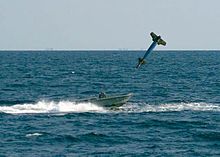avia.wikisort.org - Weapon
The GBU-10 Paveway II is an American Paveway-series laser-guided bomb, based on the Mk 84 general-purpose bomb, but with laser seeker and wings for guidance. Introduced into service c. 1976. Used by USAF, US Navy, US Marine Corps, Royal Australian Air Force and various NATO air forces.
| GBU-10 Paveway II | |
|---|---|
| Type | 2,000 lb (910 kg) unpowered guided weapon |
| Specifications | |
| Length | 14 ft 4 in (4.37 m) |
| Diameter | 18 in (460 mm) |
| Effective firing range | More than 8 nmi (9.2 mi; 15 km) |
Description

The GBU-10 has been built in more than a half-dozen variants with different wing and fuse combinations. Weight depends on the specific configuration, ranging from 2,055 to 2,103 lb (932 to 954 kg). GBU-10 bombs (along with the balance of the Paveway series) are produced by defense contractors Lockheed Martin and Raytheon. Raytheon began production after purchasing the product line from Texas Instruments. Lockheed Martin was awarded a contract to compete with Raytheon when there was a break in production caused by transferring manufacturing out of Texas.
Raytheon production of the Paveway II is centered in Arizona, Texas, and New Mexico. Lockheed Martin production is centered in Pennsylvania.
Laser-guided bombs are often labeled as "smart bombs", despite requiring external input in the form of laser designation of the intended target. According to Raytheon's fact sheet for the Paveway 2, 99 deliveries of guided munitions will yield a circular error probable (CEP) of only 3.6 feet (1.1 m), compared to a CEP of 310 feet (94 m) for 99 unguided bombs dropped under similar conditions.
On 14 February 1991, an air-to-air kill was scored by a GBU-10 when an F-15E Strike Eagle of the 335th Tactical Fighter Squadron hit an Iraqi Air Force Mil Mi-24 Hind. 30 seconds after firing, the F-15E crew thought the bomb had missed and was about to fire an AIM-9 Sidewinder air-to-air missile when the helicopter suddenly exploded.[1]
Both Lockheed Martin and Raytheon have developed GPS-guided versions of the GBU-10.[2][unreliable source?] Lockheed Martin calls its version the DMLGB (Dual-Mode LGB) GPS/INS, and the U.S. Navy issued Lockheed Martin a contract in 2005 for further development of the weapon system. The GPS/INS-equipped version of the GBU-10 produced by Raytheon is the GBU-50/B, also informally also known as the EGBU-10 (GPS/INS-enabled LGBs are frequently referred to as Enhanced GBUs or EGBUs). So far, Raytheon-built Paveway II EGBUs have only been produced for export, and have been used in combat by the British Royal Air Force over Afghanistan and Iraq.
References
- Davies, Steve (2005). F-15E Strike Eagle Units In Combat 1990–2005. London: Osprey Publishing. pp. 29–30. ISBN 1-84176-909-6.
- "Raytheon delivers Enhanced Paveway II bombs to undisclosed European country". 7 May 2013.
External links
- Raytheon's official Paveway fact page
- Globalsecurity.org Paveway fact page
- Lockheed Martin Paveway fact page
- Designation-Systems.net Paveway II fact page
На других языках
[de] GBU-10 Paveway II
Die GBU-10 Paveway II ist eine US-amerikanische lasergelenkte Bombe, die auf der Basis der Mark 84 Mehrzweck-Freifallbombe entwickelt wurde. Die GBU-10 gehört zur Paveway-Serie. Diese Bombe wurde ab dem Jahr 1976 eingesetzt. Die US Navy, Air Force und Marine Corps der Vereinigten Staaten sowie die Royal Australian Air Force und der anderen Mitglieder der NATO setzen GBU-10 ein.- [en] GBU-10 Paveway II
[fr] GBU-10
La bombe GBU-10 Paveway 2 est une bombe américaine à viseur laser basée sur la bombe largable Mk-84 mais la GBU-10 s'en distingue par l'adoption d'un viseur laser et de stabilisateur aérodynamique. Elle a été adoptée par l'USAF, l'US Navy, les US Marine Corps, l'armé de l'air australienne ainsi que quelques autres pays de l'OTAN.Другой контент может иметь иную лицензию. Перед использованием материалов сайта WikiSort.org внимательно изучите правила лицензирования конкретных элементов наполнения сайта.
WikiSort.org - проект по пересортировке и дополнению контента Википедии